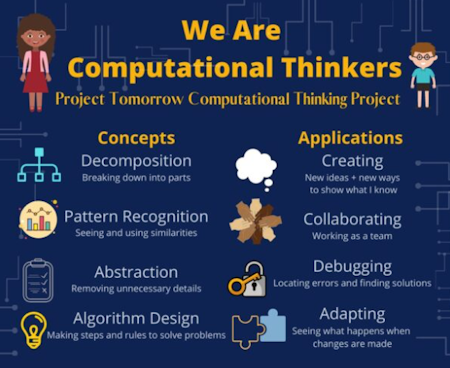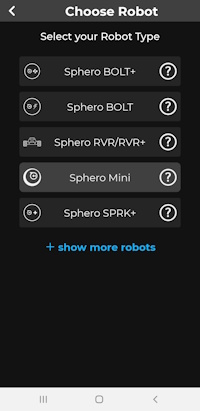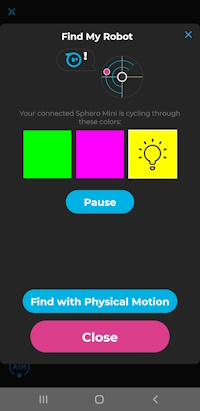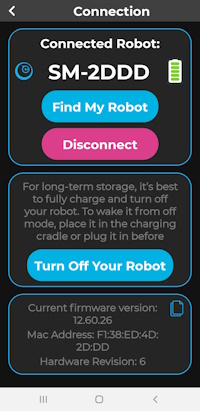November 18, 2025
Coding, Technology, and Computational Thinking But wait, there's more......https://iste.org/standards/students#1-5-computational-thinker |
- Get a Chromebook and go to WYAW.
- What
is Computational Thinking (for Teachers)?
Sources:Computational Thinking is a problem-solving process that enables students to think, learn and create to solve problems using a systematic approach to the problem or task.
"This is not about wanting everyone to become a computer scientist. Just like the ability to read, it's about computational fluency for everyone and the ability to think and create."
– Dr. Karen Brennan, Harvard School of Education

THE FOUR PILLARS OF COMPUTATIONAL THINKING:
Decomposition
- Definition: Breaking down a complex problem or system into smaller, more manageable parts.
- Example: When planning a long trip, decomposing the task into "booking flights," "finding accommodation," and "creating an itinerary".
- Example: To bake a cake, you break the process into "preparing the pan," "mixing the ingredients," and "baking the cake".
Pattern Recognition
- Definition: Identifying similarities, trends, or regularities within or among problems.
- Example: A GPS system recognizes traffic patterns to suggest the fastest route.
- Example: When sorting a large group of items, you look for patterns in their features to help you sort them more efficiently.
- Definition: Focusing on the most important information and ignoring irrelevant details.
- Example: When giving directions to a new place, you focus on the main roads and landmarks, not every single house you pass
- Example: A book summary on the back cover or a review provides the main plot points and themes, abstracting away thousands of individual sentences and words.
- Example: When teaching a computer to play chess, you represent the board and pieces in a way that captures their essential properties while ignoring things like the material they are made of.
- Definition: Developing a step-by-step set of instructions or rules to solve a problem.
- Example: The steps you follow to get ready in the morning, from brushing your teeth to getting dressed.
- Example: Creating a recipe to bake a cake, with precise instructions for each ingredient and step.
https://www.tomorrow.org/projects/computational-thinking-projects/
https://www.learning.com/blog/understanding-computational-thinking/
More examples and classroom applications: https://www.weareteachers.com/computational-thinking/
- Block Coding: This is a visual and active approach to coding that helps students build programs using blocks of code.
- Blockly https://blockly.games/
Try to do as many games as possible and get up to level 5 for the game(s) you choose!
- Octostudio (app) on the iPads or Android Tablets
- Blockly https://blockly.games/
- Spheros and the app on your phone - Three ways to control the spherical robot (Drive, Draw, Code/Program)
- Open Sphero Edu on your phone (tablets are available if needed)
- Today we are just going to get comfortable with "driving" the Spheros and using the accessories.
Choose Drive/Touch Control - Find and pair your device with your Sphero. Make sure to choose the correct Sphero and not someone else's
- Calibrate the Sphero by using Aim to aim the light on the Sphero toward you
- Use the remote control on your phone/iPad to move the Sphero and change speed, etc.
- Disconnect from the top right icon.




- Using the kit of accessories - EXPLORE!!
RESOURCES O' THE DAY:
A Great Educational Coding Website
https://www.codeforlife.education/
Top Coding Websites for Kids
https://codakid.com/top-21-kids-coding-websites-of-all-time/
10 Free Coding Games Websites for Teaching Programming Skills
https://childhood101.com/coding-for-kids/
Hour of Code
https://hourofcode.com/us
Why teach robotics in schools?
https://blog.robotiq.com/7-reasons-to-teach-robotics-at-school
Computational Thinking Competencies
https://www.iste.org/standards/computational-thinking
Computational Thinking Teacher Resources (RICH RESOURCE)
https://id.iste.org/docs/ct-documents/ct-teacher-resources_2ed-pdf.pdf?sfvrsn=2
A Comprehensive List of Coding Resources
https://mommypoppins.com/coding-kids-free-websites-teach-learn-programming
Videos on Computational Thinking and Coding:
Computational thinking: A digital age skill for everyone
https://www.youtube.com/watch?v=VFcUgSYyRPg&t=1s
Other Videos from ISTE
https://www.youtube.com/user/istevideos/search?query=computational+thinking
A Fabulous and Free Coding Website for Kids from MIT - Scratch
https://scratch.mit.edu/projects/editor/?tutorial=getStarted
Sphero
Overview of Sphero for Teachers from the Company
https://cdn.shopify.com/s/files/1/0306/6419/6141/files/SpheroEdu-k12-teacher-resource-guide.pdf?v=1585146735
Teacher's Guide
https://dmmedia.sphero.com/email-marketing/Sphero-Edu/SpheroEdu-k12-teacher-resource-guide-v1_updated050818.pdf
A list of Sphero Challenges from a classroom teacher in Georgia
